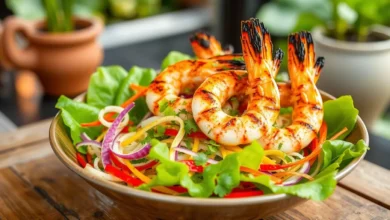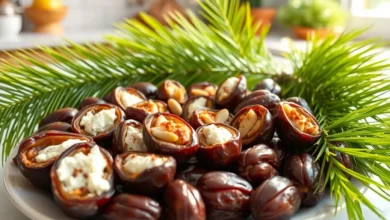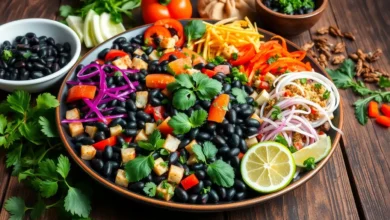10 Spicy Scotch Bonnet Recipes to Heat Up Your Meals
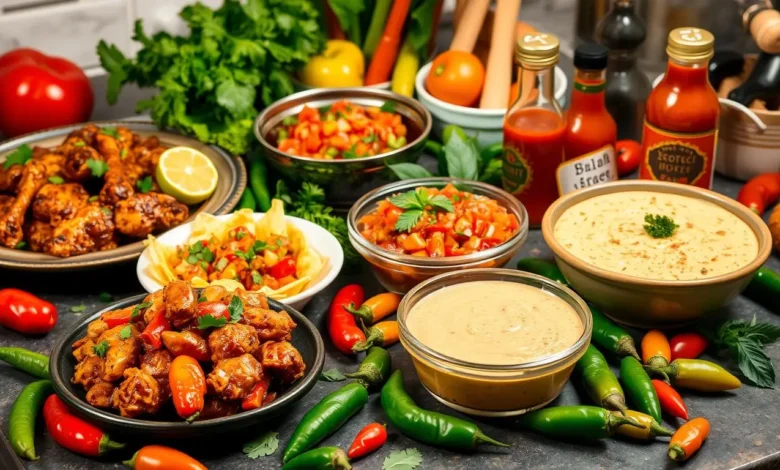
The scotch bonnet pepper comes from the Caribbean and is known for its bright color and intense heat. It has a fruity taste that can make simple dishes exciting. We’ve picked 10 spicy scotch bonnet recipes to spice up your meals.
These recipes include Caribbean-Style Jerk Chicken and Fiery Scotch Bonnet Hot Sauce. You’ll also find Jamaican dishes, a sweet and spicy mango salsa, and vegetarian options. They all use the scotch bonnet’s unique flavor.
Exploring scotch bonnet peppers can add a new level of taste to your cooking. Whether you love spicy food or want to try Caribbean cuisine, these 10 recipes will make your meals more exciting.
Understanding Scotch Bonnet Peppers: Heat Level and Flavor Profile
Scotch bonnet peppers are known for their bold flavor. They are bright, lantern-shaped, and pack a lot of heat. With a Scoville rating of 100,000 to 350,000 units, they are much hotter than jalapeños and habaneros.
Their flavor is sweet and fruity, with hints of citrus, mango, and tropical notes. This makes them great for adding a unique kick to many dishes.
What Makes Scotch Bonnets Different from Other Hot Peppers
Scotch bonnets look and taste different from other super-hot peppers. Unlike habaneros, which have a smoky flavor, scotch bonnets are sweet, like apricots. This unique taste makes them a hit among chili lovers and food explorers.
How to Handle and Store Scotch Bonnets Safely
- Always wear gloves when handling scotch bonnets to avoid skin irritation.
- Wash your hands thoroughly with soap and water after working with the peppers.
- Store scotch bonnets in the refrigerator, where they will keep for up to two weeks.
- Freeze scotch bonnets for longer-term storage, which can preserve their flavor and heat for several months.
Knowing about the heat and flavor of scotch bonnet peppers lets you use them safely and enjoy their bold taste in your cooking.
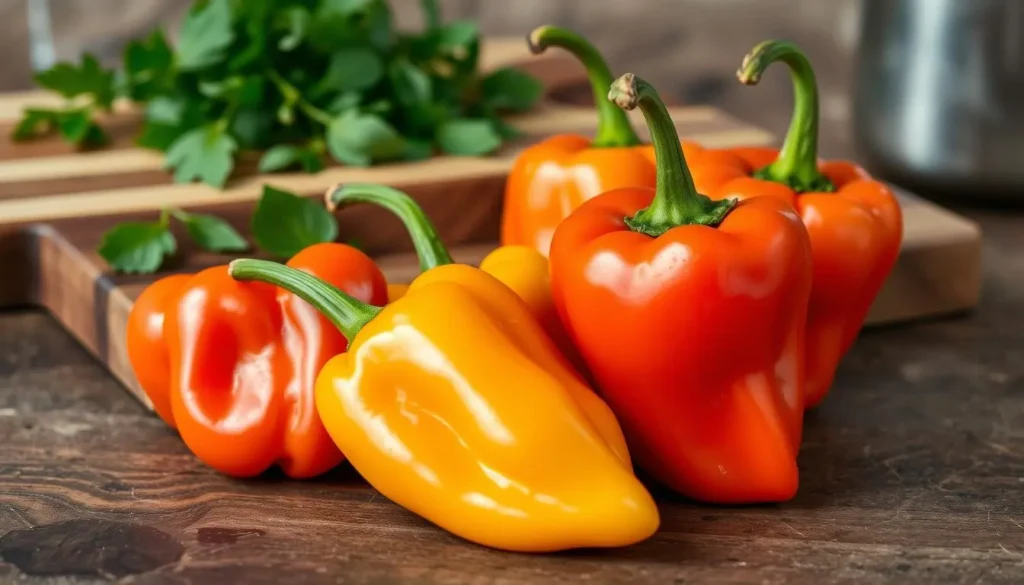
Caribbean-Style Jerk Chicken with Scotch Bonnet Marinade
Take your grilling to the next level with this jerk chicken recipe from the Caribbean. The secret is the scotch bonnet marinade. It adds a thrilling heat and depth to the chicken.
To make perfect jerk chicken, start with a strong marinade. Mix scotch bonnet peppers, garlic, ginger, allspice, thyme, and brown sugar. Let the chicken soak in it for 2 hours or up to 24 hours for the best flavor.
When grilling, the magic happens. Sear the chicken over high heat for a charred crust. Then, cook at medium-low until the juices are clear. You’ll get Caribbean-style jerk chicken that’s full of flavor.
Enjoy your jerk chicken with rice and peas, roasted sweet potatoes, or a cool coleslaw. The scotch bonnet marinade and the chicken’s savory taste will take you to the tropics. Try this jerk chicken recipe and taste the Caribbean!
| Ingredient | Quantity |
|---|---|
| Chicken thighs or drumsticks | 6-8 pieces |
| Scotch bonnet peppers, minced | 2-3 peppers |
| Garlic, minced | 6 cloves |
| Fresh ginger, grated | 2 tablespoons |
| Ground allspice | 2 teaspoons |
| Fresh thyme leaves | 2 tablespoons |
| Brown sugar | 2 tablespoons |
| Olive oil | 1/4 cup |
| Salt and pepper | To taste |

Be careful with the scotch bonnet peppers. They’re very spicy. Wear gloves and avoid touching your eyes or face while preparing.
Fiery Scotch Bonnet Hot Sauce from Scratch
Making your own hot sauce is a fun and rewarding experience. The scotch bonnet pepper is perfect for creating a fiery and flavorful sauce. By making it yourself, you can choose the ingredients, adjust the heat, and enjoy a Caribbean-inspired taste.
Fermentation Tips for Better Flavor
Fermentation is key to a great scotch bonnet sauce. It lets the peppers, garlic, and other ingredients develop a rich flavor. Here are some tips for making the best homemade hot sauce:
- Use a digital scale to accurately measure the weight of your ingredients, ensuring the perfect balance for fermentation.
- Invest in an airlock system to create an anaerobic environment, promoting the growth of beneficial bacteria and preventing unwanted mold or yeast.
- Monitor the fermentation closely, checking for signs of activity and adjusting the temperature as needed to maintain the ideal conditions.
Storage and Shelf Life Guidelines
After your scotch bonnet sauce recipe is fermented to perfection, it’s crucial to store it right. This will help it last longer. Here are some tips to keep your fermented hot sauce fresh:
| Storage Condition | Shelf Life |
|---|---|
| Refrigerated | 6-12 months |
| Room Temperature | 3-6 months |
Always store your homemade hot sauce in a sealed container. Adding a bit of vinegar or lemon juice can also help it last longer.
Spicy Scotch Bonnet Recipes for Traditional Jamaican Dishes
Jamaican food is known for its bold flavors, and scotch bonnet peppers are key. These peppers add a special heat and depth to Jamaican dishes. They make the food even more deliciously spicy.
Escovitch fish is a classic Jamaican dish that highlights scotch bonnets. It’s a tangy, slightly sweet fish dish loved in Jamaican homes and restaurants. The scotch bonnet’s heat complements the vinegar marinade perfectly.
- Curry goat is another iconic Jamaican recipe with scotch bonnets. The curry’s earthy, aromatic flavors get a boost from the scotch bonnet’s fiery kick. This creates a complex, addictive taste.
- No Jamaican meal is complete without rice and peas. This dish also features scotch bonnet peppers. It’s made with coconut milk, thyme, and other spices for a fragrant flavor.
These examples show how Jamaican cuisine uses scotch bonnets to add bold, spicy flavors. Whether it’s in a hearty stew, a zesty marinade, or a fragrant rice dish, scotch bonnets are a true highlight. They showcase the rich culinary traditions of the Caribbean.
“The scotch bonnet is the heart and soul of Jamaican cooking. It’s what gives our dishes their fiery personality and makes them truly unforgettable.”
– Jamaican Chef, Dine Irie
Sweet and Spicy Scotch Bonnet Mango Salsa
Bring vibrant Caribbean flavors to your table with a delectable mango salsa. It features bold and zesty scotch bonnet peppers. This sweet and spicy condiment is great with grilled meats, fish, or as a dip for chips.
Fruit Pairing Suggestions
Mango is the star of this salsa, but scotch bonnets add a spicy kick. You can also add diced pineapple, papaya, or a hint of lime. These fruits balance the heat and create a well-rounded flavor.
- Mango
- Pineapple
- Papaya
- Lime
Serving Temperature Recommendations
Serve this mango salsa recipe chilled for the best flavor. The cool temperature brings out the sweetness of the fruit. It also makes the onions and peppers crunchy. Adjust the spice by adding more or less scotch bonnet peppers.
| Ingredient | Quantity |
|---|---|
| Ripe mango, diced | 2 cups |
| Red onion, finely chopped | 1/2 cup |
| Scotch bonnet pepper, minced | 1-2 tablespoons |
| Cilantro, chopped | 1/4 cup |
| Lime juice | 2 tablespoons |
| Salt | 1/2 teaspoon |
“The combination of sweet mango and fiery scotch bonnet peppers creates a flavor explosion that will tantalize your taste buds.”
Scotch Bonnet Pepper Infused Oils and Vinegars
Make your dishes more exciting with scotch bonnet peppers. Create your own infused oils and scotch bonnet vinegar. These spicy condiments add a great kick to many recipes, like marinades, sauces, dressings, and dips.
Infusing Oils with Scotch Bonnets
To make scotch bonnet-infused oil, start by slicing or chopping the peppers. Make sure to leave the seeds in for extra heat. Heat a neutral oil like grapeseed or avocado oil in a saucepan.
Add the peppers to the oil and let it simmer for 20-30 minutes. Then, remove it from heat and let it cool. Strain the oil through a fine-mesh sieve and store it in a clean, airtight bottle.
Crafting Scotch Bonnet Vinegar
Try making your own scotch bonnet vinegar for a spicy twist. Mix whole or chopped scotch bonnets with vinegar like apple cider or white wine in a glass jar. Seal it and let it steep for 2-4 weeks, shaking it now and then.
Once it reaches your desired heat and flavor, strain the vinegar through a fine-mesh sieve. Then, transfer it to a clean bottle for storage.
| Infused Oil | Suggested Uses |
|---|---|
| Scotch Bonnet Pepper Oil | Drizzle over grilled meats or vegetablesUse as a marinade for seafood or poultryIncorporate into salad dressings or dips |
| Scotch Bonnet Vinegar | Add to vinaigrettes and saucesPickle vegetables for a spicy twistUse as a flavor enhancer in soups and stews |
Be careful when handling scotch bonnets because they are very hot. Always wear gloves and avoid touching your eyes or face. Enjoy the bold flavors these infused oils and scotch bonnet vinegar add to your cooking!
Caribbean Fish Stew with Scotch Bonnet Peppers
Dive into the depths of Caribbean cuisine with a robust and flavorful Caribbean fish stew. It features the iconic scotch bonnet peppers. This vibrant and spicy dish is a true delight for the senses. It blends the fresh catch of the sea with the fiery kick of the scotch bonnets.
Best Fish Varieties to Use
When crafting your Caribbean fish stew, choose fish varieties that can handle the bold flavors of the scotch bonnets. Some excellent choices include:
- Snapper: Its firm, delicate flesh holds up well in the stew.
- Mahi-mahi (also known as dolphinfish): This versatile fish adds a subtle sweetness.
- Grouper: With its meaty texture, grouper is a fantastic option for this hearty stew.
- Shrimp: A classic addition that brings both flavor and texture to the dish.
Adjusting Heat Levels
The scotch bonnet peppers are the star of this Caribbean fish stew, bringing a fiery kick. For a milder version, start with just one or two peppers, carefully seeding and dicing them. For a more intense heat, add an extra scotch bonnet or two, but be mindful of the spice level as these peppers pack a punch!
No matter how you adjust the heat, the combination of fresh seafood and vibrant, spicy scotch bonnets creates a captivating Caribbean fish stew. It is sure to warm your soul and delight your taste buds.
Spicy Vegetarian Options Using Scotch Bonnets
Spice up your vegetarian meals with scotch bonnet peppers. These Caribbean staples add a unique heat. They work well in many plant-based dishes, like vegetable curries and grilled skewers.
Scotch bonnets are great in Caribbean vegetarian dishes. They have fruity, floral notes that go well with tropical ingredients. Try them in spicy bean stews, vegetable rices, or creamy dips.
When using scotch bonnets, handle them carefully. Wear gloves and avoid touching your face until you’ve washed your hands. Start with a little and add more heat as you like. These peppers can make simple meals into something special.
| Vegetarian Scotch Bonnet Recipes | Key Ingredients | Unique Flavor Notes |
|---|---|---|
| Scotch Bonnet Jerk Tofu Skewers | Tofu, scotch bonnet peppers, allspice, thyme, coconut oil | Savory, smoky, and fiery |
| Creamy Scotch Bonnet Sweet Potato Curry | Sweet potatoes, scotch bonnet peppers, coconut milk, curry powder | Subtly sweet, with a kick of heat |
| Grilled Pineapple and Scotch Bonnet Salsa | Pineapple, scotch bonnet peppers, red onion, cilantro, lime juice | Fruity, spicy, and refreshing |
Discover the unique flavors of scotch bonnet peppers. They can turn your meatless meals into culinary wonders. Explore vegetarian scotch bonnet recipes and Caribbean vegetarian cuisine.
Quick and Easy Scotch Bonnet Dipping Sauces
Scotch bonnet peppers add a delightful kick to many dishes. They’re great in bold sauces and simple dipping sauces. These sauces bring Caribbean heat to your meals.
Complementary Ingredients
Creating a great scotch bonnet dipping sauce means balancing the peppers’ heat. You can use:
- Citrus (lime, orange, grapefruit)
- Tropical fruits (mango, pineapple, papaya)
- Aromatic herbs (cilantro, thyme, basil)
- Pungent alliums (garlic, onion, shallot)
- Acidic elements (vinegar, yogurt, sour cream)
Perfect Pairings Guide
Scotch bonnet sauces are great with grilled meats, seafood, roasted veggies, and salads. Try these pairings:
| Dish | Recommended Scotch Bonnet Dipping Sauce |
|---|---|
| Jerk Chicken | Scotch Bonnet and Lime Yogurt Sauce |
| Grilled Fish Tacos | Scotch Bonnet and Pineapple Salsa |
| Roasted Sweet Potato Wedges | Scotch Bonnet and Garlic Aioli |
| Grilled Vegetable Skewers | Scotch Bonnet and Mango Chutney |
With a bit of creativity and knowledge of flavors, you can make tasty scotch bonnet sauces. They’re perfect for adding heat to your dishes or exploring Caribbean flavors. These easy recipes will be a favorite in your kitchen.
Safety Tips When Cooking with Scotch Bonnets
Working with scotch bonnet peppers requires careful handling. These peppers are small but very spicy. It’s important to handle them safely to avoid any surprises.
Protective Measures
- Always wear gloves when handling scotch bonnet peppers. The oils in the peppers can irritate your skin, and you don’t want to accidentally rub your eyes after touching them.
- Work in a well-ventilated area to prevent the pepper fumes from causing respiratory irritation.
- Avoid touching your face or any sensitive areas while working with the peppers.
First Aid for Pepper Burns
If you get a scotch bonnet pepper burn, don’t worry. Here’s what to do:
- Rinse the affected area with cold water to help cool the burn.
- Apply a soothing ointment, such as aloe vera gel, to the irritated skin.
- Avoid rubbing the eyes or touching any other sensitive areas until the burning sensation subsides.
Cleaning and Sanitizing
After handling scotch bonnet peppers, clean everything well. This prevents cross-contamination. Here’s how:
- Wash all cutting boards, knives, and other tools with hot, soapy water.
- Sanitize the work surfaces using a diluted bleach solution or a food-safe disinfectant.
- Launder any clothing or towels that came into contact with the peppers.
By following these pepper safety tips, you can safely use scotch bonnet peppers in your cooking. This way, you can enjoy their flavor without any heat-related problems.
Conclusion
The Scotch bonnet pepper adds a burst of flavor to many Caribbean dishes. It makes jerk marinades fiery and mango salsas zesty. These peppers mix heat with a complex aroma that excites your taste buds.
Exploring Scotch bonnet uses has opened up new flavors for you. You can make homemade hot sauce or spice up oils and vinegars. These peppers bring a spicy, tropical taste to your food.
Keep exploring scotch bonnet culinary uses, spicy recipe ideas, and Caribbean flavor exploration. Be careful with these peppers, but with practice, you’ll get better. Soon, you’ll be making dishes that everyone will love.
FAQ
What makes scotch bonnet peppers different from other hot peppers?
Scotch bonnet peppers are known for their fruity taste and intense heat. They have a Scoville heat rating of 100,000 to 350,000 units. This makes them much hotter than jalapeños or serrano peppers.
Their unique flavor sets them apart from other hot peppers. This flavor makes them special in cooking.
How should I handle and store scotch bonnet peppers safely?
When handling scotch bonnet peppers, wear gloves to avoid skin irritation. Avoid touching your face or eyes after handling the peppers. To store, place the whole peppers in an airtight container in the refrigerator.
They can last for up to two weeks this way. Proper storage and handling keep the peppers fresh and potent.
How can I adjust the heat level when cooking with scotch bonnet peppers?
To reduce the heat, remove the seeds and membranes. These parts have most of the capsaicin. Using fewer peppers or substituting with milder chili varieties can also help.
Balancing the spiciness with acidic ingredients like lime juice or vinegar can also help tame the heat.
What are some tips for making a flavorful, fermented scotch bonnet hot sauce?
For a complex, fermented scotch bonnet hot sauce, ferment the peppers, garlic, and other ingredients for 2-4 weeks. This process develops deeper flavors and a pleasant tanginess. Be sure to use a weight to keep the ingredients submerged in the brine.
After fermentation, blend the mixture and strain it for a smooth, balanced hot sauce.
How can I safely handle and clean up after cooking with scotch bonnets?
When cooking with scotch bonnet peppers, wear gloves and avoid touching your face or eyes. After use, thoroughly clean all surfaces, utensils, and hands with soap and water to remove any residual pepper oil.
If you experience irritation, flush the affected area with cool water. Seek medical attention if the discomfort persists.

